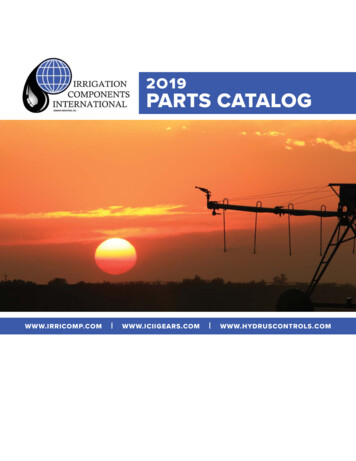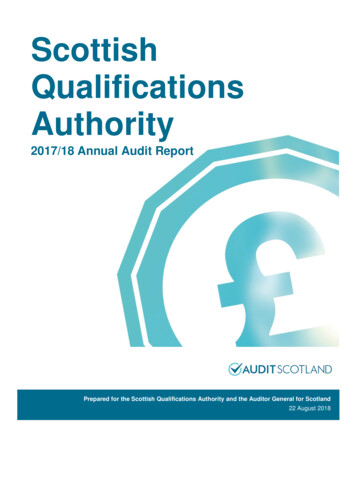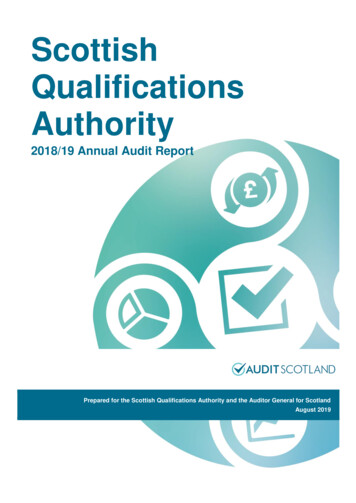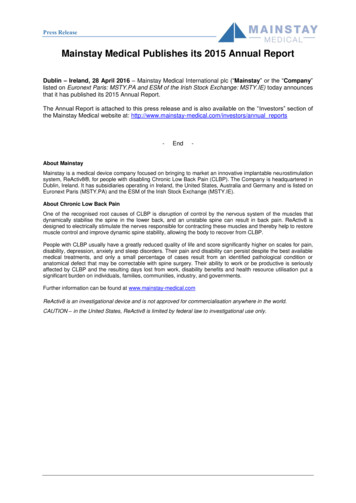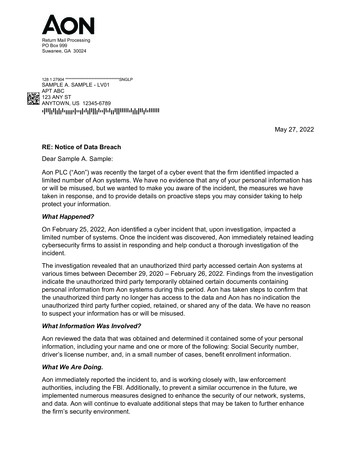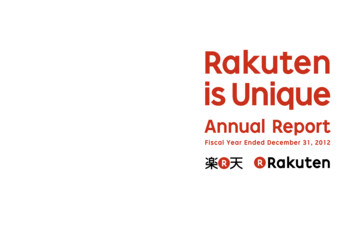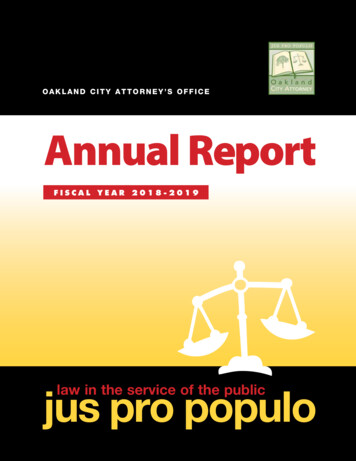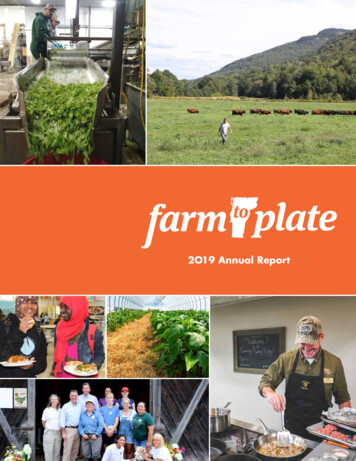
Transcription
2O19 Annual Report1
Table of ContentsLetter to the General Assembly and Governor page 012017 Census of Agriculture Highlights page 02Network Project HighlightsExploring More Viable Approaches to Operating a Grass-Fed Beef Business page 06Local Planning for Food Access: A Toolkit for Vermont’s Communities page 08From Field to Woods to Fork: Rooted in Vermont Celebrates Local Food page 10Supporting the Future of Vermont’s Dairy Sector page 11Local Foods Wholesale Market Assessment—Trends and Tools for Success page 12Resources to Support Small-Scale On-Farm Composting page 14AdministrativeThe Value of the Network page 17Farm to Plate Network Leadership page 18The Network at a Glance page 19The Gathering page 20Financials page 22Funding Partners page 22About Vermont Sustainable Jobs Fund page 23Staff page 232
To: Vermont General Assembly and Governor Phil ScottAchieving Intended OutcomesThis year’s Annual Report features highlights of key projectsfrom 2019, including grass-fed beef industry development, localplanning for food access, wholesale markets, and small-scaleon-farm composting. You will also see how Rooted in Vermontcontinues to engage Vermonters through inventive partnerships,the ways we are supporting the future of Vermont’s dairy sector,and a snapshot from the latest Census of Agriculture release.These selections are not meant to show the entirety of activityhappening in the Network or the food system as a whole, butrather show the breadth of activity and diversity of stakeholdersand sectors Farm to Plate is engaged with in strengtheningVermont’s food system.What you also won’t see in the pages ahead is the extent of workthat is happening in parallel with our normal Network activity,to position us for the next decade of food system development.This work started in May 2019 with the Governor’s signing of Act23: An act relating to the Farm to Plate Investment Program,which extends Farm to Plate to January 1, 2031:The reauthorization of Farm to Plate is, on one hand, anaffirmation of the progress made in food system economicdevelopment since Farm to Plate’s beginnings in 2009. From 2007 to 2017, Vermont food system economic outputexpanded 48%, from 7.5 to 11.3 billion. From 2009 to 2018, net new food system employmentincreased by 6,529 jobs (11.2%). In total, over 64,000 people and 11,500 businesses arenow part of Vermont’s food system.Yet, reauthorization also acknowledges that there are goals wehave not yet achieved and new challenges to be addressed—reflected by a dairy industry in transition, increasing marketcompetition and price pressure faced by producers, significantgenerational transfer of farmland and farm assets, persistentfood insecurity and lack of equitable access to healthy localfood—all of which will require sustained and coordinatedstrategic action.A RENEWED PLAN FOR THE NEXT 10 YEARS IS NEEDEDTO RE-ESTABLISH A COMMON VISION AND AGENDA,WITH UPDATED AND PRIORITIZED STRATEGIES ANDACTION STEPS. In partnership with the Agency of Agriculture,Food and Markets, and in fulfillment of Act 83: An act relating toagricultural development, we are setting the foundations of thenext Farm to Plate Plan. Act 83, signed into law in June, includesa stipulation to submit a report of recommendations to stabilize,diversify, and revitalize Vermont’s agricultural industry byJanuary 15, 2020, to the Senate Committee on Agriculture andthe House Committee on Agriculture and Forestry. In helping tocreate the Act 83 report, we are also beginning to create the nextFarm to Plate Strategic Plan.Working with food system subject matter experts, the reportconsists of 23 product, market and issue briefs spanning productareas (produce, grass-fed beef, dairy, hemp/CBD), marketchannels (institutions, direct markets, retail), and issue areas(climate change, access to capital, land access, soil health andwater quality). The briefs cover current conditions, bottlenecksand gaps, opportunities, and finish with recommendations.A second phase of briefs is now underway, addressing productareas and issues that could not be covered in the first phasetimeline, with an aim to complete them by April 2020.Upon completion of all of the briefs, Farm to Plate will undertake a stakeholder engagement process to further refine and prioritizestrategies and recommendations to develop a shared vision for the Farm to Plate 2.0 Strategic Plan. A list of high priority recommendationsidentified through the stakeholder process will be completed by September 2020, with results shared at the 2020 Farm to Plate NetworkAnnual Gathering. The final synthesized report, with high priority strategies, recommendations, and vision statement, will be deliveredto the legislature in January 2021 to officially commence Farm to Plate’s next 10-year cycle. We are grateful for the continued supportfrom the Legislature and Scott Administration to strengthen Vermont’s Food System now and into the next decade.Jake ClaroFarm to Plate Director3
2017 Census of Agriculture: Vermont HighlightsMarket Value 776M 800M 781M 674M 700M 600MOf the 780,968,000 of agricultural productssold in Vermont in 2017: 49,971,000 (6.4%) was from direct-to-consumer sales. 500M 54,134,000 (6.9%) was from sales direct to retail,institutions, and food hubs for local or regionallybranded products. 400M 300M 200M 593,872,000 (76%) were livestock, poultry, andtheir product sales (e.g., milk, meat, and eggs.) 100M0200720122017 187,096,000 (24%) were crops, including nursery andgreenhouse crops (e.g., grains, hay, vegetables, tree fruits,berries, floriculture, and maple syrup.)In addition to commodity sales, farms reported 49,487,000of sales from on-farm value added products.Farm and Lands in AgricultureThough the Census of Agriculture defines a farm as any place from which 1,000 or more of agricultural products were produced andsold, many stakeholders in Vermont believe 10,000 of gross sales is a better threshold and indicator of a farms commercial status and/oraspirations. Of the 6,808 farms counted in the Census, only 2,852 (42%) gross more than 10,000 or more.Land in Acreage in Agriculture Over TimeNumber of 01220170200720122017Land in Acreage in Agriculture by Type in 2017421K (35%)434K (36%)116K(10%)4Dairy Cattle & Milk ProductionGreenhouse, Nursery, & Floriculture ProductionHay Farming & All Other Crop FarmingOilseed & Grain FarmingBeef Cattle Ranching & FarmingVegetable & Melon FarmingAquaculture & Other Animal ProductionPoultry & Egg ProductionSheep & Goat FarmingCattle FeedlotsFruit & Tree Nut FarmingHog & Pig Farming223K (19%)
Demographics of Producers9%10%75 years under 35 years42%Female58%32%49%Male35–54 years55–74 yearsRace and Ethnicity of Producers 2007–2017125Hispanic or Latino Origin100Native Hawaiian or Other Pacific Islander75Black or African American50Asian25American Indian or Alaska Native0200720122017Where Are Vermont’s Young Farmers?15% of farms in Vermont have a “young operator” (age 35 or below). These farms steward256,363 of 1,193,437 farmland acres (21%) and create 30% of total market value.When looking by farm type, 31% of vegetable farms, 27% of dairy farms, 20% of sheep and goat farms, 13% of fruit tree farms, and9% of beef farms have young operators. While these figures demonstrate a foundation of youth involvement in farming in Vermont thatshould not be diminished, they also reveal an equivalent of 937,074 acres of land that doesn’t have a producer under the age of 35involved in the farming of that land.Distribution of Farms with Young Operators by Farm Type vs All Farms by Farm Type10%Farms withYoung Operators5%All 0%Hog & Pig FarmingHay Farming & All Other Crop FarmingOilseed & Grain FarmingVegetable & Melon FarmingBeef Cattle Ranching & FarmingPoultry & Egg ProductionFruit & Tree Nut FarmingCattle FeedlotsSheep & Goat FarmingGreenhouse, Nursery, & Floriculture ProductionDairy Cattle & Milk ProductionAquaculture & Other Animal Production5
Exploring More Viable Approachesto Operating a Grass-Fed Beef BusinessGrass-fed beef value chain development brings renowned livestock school to Vermont, results indirect investments in grass-fed beef farms and better linkages and specialization between farmsto increase throughput, better utilize land, leverage farmers’ production strengths, and foster anenvironment conducive to strategic cooperation.HOW CAN MEAT PRODUCTION SYSTEMSIN VERMONT BE IMPROVED?In response to this question, Farm to Plate Network membersidentified a need to better understand market demand for grassfed meat products in the Northeast, deliver improved technicalassistance, and define viable production models for Vermontlivestock operations. The Network conducted grass-fed beefmarket research (2017–2018) and developed budgeting templatetools to standardize cost accounting for grass-based farmers.Building off this work, stakeholders recognized the need for anintensive learning environment to stimulate business growth,management acumen, and industry leadership. To do this, Farmto Plate negotiated with Ranch Management Consultants to bringthe renowned Ranching for Profit School (RFP) to the Northeast forthe first time.The weeklong school ran from February 3–9, 2019 with 14 Vermontersattending, out of 45 total farmers and ranchers representing 12states across the U.S., Canada and Australia. Attendees were broughtthrough what one attendee described as a 7-day MBA program,deeply analyzing cash flow, gross profit margins, human resourcesand management, technical livestock management practices andgrazing concepts to increase animal and soil health.6Upon graduation, Farm to Plate grants were made available tothe Vermont cohort to help accelerate implementation of theirlearning and plans developed during RFP. Nine beef producersreceived a total of 66,748 for projects including: Portable animal handling, scales, and fencing to improvelabor efficiencies in handling, sorting, and receiving animalsand to improve grazing and land utilization on leased land. Marketing and inventory management improvementsto improve the logistics of online meat sales, labeling andpackaging design, inventory management, refrigerationcapacity, and marketing capabilities. Grazing management improvements to further educationof grazing practices, implement a new cell grazing plan andallow for better pasture utilization.
ImpactsMany of the farmers who attended RFP called it a game changer. The grants had immediate impacts on the farms and theirability to scale faster, market more product, improve management efficiencies and reduce costs of production.“The new corral system allowed us to quickly draw bloodsamples from the entire herd, and has made sorting, loading,and working much more efficient. It has allowed us to scaleour operation and implement the action plan from Ranchingfor Profit; reducing the labor cost with handling was a keytake-away from the school. We are now working with a localdistributor on a new local, grass-fed line to expand ourmarkets and sales.”—Justin SauerweinAlmanack Farm“RFP helped us identify where we could fit in the supply chainas custom grazers. The grant we received helped us set up asecure training area with both woven wire and corral panels.Now we can easily take in short term and stocker cattle, andcomfortably get them trained to fence and ease the transitiononto our farm. We have used this new infrastructure this yearto bring in 85 animals to date with 56 more arriving soon.”—Marc and Cheryl CesarioMeeting Place PasturesTakeaways and Next StepsThe Ranching for Profit experience not only improved themanagement of individual farms but led to better linkages andspecialization in Vermont between beef farms in order to increasethroughput, better utilize land, leverage existing productionstrengths, and foster an environment amongst farmers that isconducive to more strategic cooperation. The Vermont cohort ishelping create a more integrated grass livestock industry in Vermontand demonstrating more viable approaches to operating a grassfed livestock business. RFP, along with the market research andbudgeting tools, are catalyzing the creation of a production supplychain that links multiple Vermont farms together in conceiving,raising, and finishing livestock while simultaneously keeping theworking landscape intact and improving its ecosystem servicesthrough improved grazing practices and management.However, challenges still remain for growing Vermont’s grass-fedbeef industry. RFP graduates reported: Struggles acquiring contiguous land; Need for improved genetics programs to breed animalssuited for Vermont; Issues with importing stockers and feeders from out of state; Federal place of origin labeling laws that allowinternationally raised grass-fed beef to be labeledas products of the United States; Limited marketing resources to educate consumers; High upfront costs for infrastructure and deferred incomefrom converting degraded farmland into productive pasture; High processing costs that put producers at a competitivedisadvantage with national brands; and Lack of awareness of the unique skills and competencies neededto successfully raise beef livestock animals on pasture. There’san assumption that dairy animal management practices aresynonymous and compatible with grass-fed beef livestockproduction, and this is not the case.In the coming year, Farm to Plate will work to convenegrass-fed beef stakeholders again in order to examine thesechallenges more in-depth, prioritize market developmentneeds, and launch a new phase of strengthening the industry.7
Local Planning for Food Access:A Toolkit for Vermont’s CommunitiesSupporting the economic viability of local farms and increasing food access for all communitymembers are often treated as separate, or even conflicting, objectives. The Farm to Plate Network,however, works to address these issues simultaneously, as both are necessary for economicstability and thriving communities. While models can be developed and sometimes implementedby statewide organizations, sustainable change depends on capacity being built within individualcommunities. Fortunately, Vermonters care about the food security of their neighbors and manycommunities are proactively looking for ways to strengthen their own local food system. The Farmto Plate Network has spent two years collecting insight from a wide variety of experts to createLocal Planning for Food Access: A Toolkit for Vermont’s Communities, released in November 2019.One of the best ways for Vermont communities to articulate theircollective values and strategically address their challenges isthrough the local planning process. A municipal or regional plancan influence the local food system in a number of ways, fromraising awareness, to prompting residents to take action onconcrete projects, to establishing regulations. The food system,including food access, is closely related to many other topicsrequired or frequently addressed within these plans, such as landuse, economic development, health, and more. Local Planningfor Food Access is a new addition to a series of resourcespreviously created by Farm to Plate on food systems andagricultural land use planning, with a greater focus on foodaccess and especially on strategies that benefit bothproducers and those facing food insecurity.8
This initiative has been a collaborative effort between over 20experts from a wide range of food system organizations, stateagencies, and regional commissions. The final resource: Makes the case for addressing food access at the local level; Articulates the relationship between food access, localfood production, and other issues of concern to Vermontcommunities; Presents many different strategies for increasing food access,describes how a community can determine the best approach,and identifies sources of support for design andimplementation; and Highlights success stories from communities all aroundthe state.While much of the resource dissemination, including direct outreachto local planning commissions, will be occurring in 2020 and beyond,a number of workshops have already been presented.For the project team, the process itself has led to a deeperunderstanding of the relationship between local food productionand community food access, and the diversity of ways in whichthis manifests across the state. For example, many communitiescould benefit from a new farmers market. However, becauseVermont already has a high density of farmers markets, each ofwhich needs a large enough customer base to make it financiallyviable for vendors, there are also cases where creating a newmarket is not an appropriate solution. The Toolkit addresses thisconsideration and highlights alternatives such as partneringwith neighboring communities on mobile markets or helpingnearby existing markets accept 3SquaresVT benefits.“Like water and shelter, food access is one of those things we take forgranted until it’s not there. Access to food is more than a function ofbeing able to pay for it. It’s also a function of mobility, land use, localeconomic conditions and other factors. Can you get to where thefood is, or can the food get to you? Do local land use regulationscreate barriers to food production and access? What kinds offood and food retail does the local economy currently support?Food access requires thoughtful and intentional planning andimplementation. This Toolkit provides a foundation for multiple foodaccess planning pathways for citizen planners.”—Chris CampanyExecutive Director, Windham Regional CommissionTakeaways and Next StepsThis project brought together a coalition of organizations witha shared interest in empowering Vermont’s communities to addressfood access at the local level. Local Planning for Food Access notonly provides information for those communities ready to get towork, but also illustrates the common ground between thoseworking on food access, economic welfare, housing,transportation, and more.Over the coming year, Farm to Plate will disperse the resource widelyand provide on-the-ground advising for interested communities.Bringing a wide variety of expertise directly into communitiesis key to making lasting impact, as the project has affirmed thatevery community’s local food system challenges and opportunitiesare complex and unique.Even with Vermonters’ willingness to tackle the issue andthe information and expertise available, challenges remain: Communities are especially supportive of addressing foodaccess with local food production. However, many of thebarriers that hamper farmers’ ability to offer food at a pricepoint competitive with non-local food, or even to physicallyoffer their food in their own community at all, are wellbeyond the ability of a municipality to affect. There is onlyso much progress that can be made locally without broadersystemic change in the state and beyond.Nevertheless, there are solutions that communities can implementas a valuable piece of the puzzle. And the more that Vermontersengage in collective conversation around local food access andintegrate food systems into their community vision, the moredesire and capacity grows to address those resource gaps andsystemic barriers at a statewide scale. As with most issues of local concern, many communitiesare eager to address food access in their visioning andplanning processes, but have a harder time identifyingresources to implement their preferred solutions.9
From Field to Woods to Fork:Rooted in Vermont Celebrates Local FoodWith the goal of creating more consumer demand for local food, Rooted in Vermont has continuedto reach Vermonters in all corners of the state as it celebrates all of the great ways that folks areconsuming local food in their own unique ways.Whether it’s sharing gardening tips and favorite recipes with Vermonters at state fairs and festivals, chatting about hunting and fishingat events with the Vermont Department of Fish and Wildlife, exploring all the food found in Vermonters backyards with the VermontDepartment of Libraries, or celebrating favorite farms, farm stands, and farmers markets through Vermont Open Farm Week, much ofRooted in Vermont’s work has been made possible because of partnerships with other organizations and Vermont governmental agencies.IN THE VERMONT COMMUNITYThis past year, Rooted in Vermont had a presence at 15 differentfairs, festivals, and town celebrations. From St. Johnsbury toBrattleboro to Hartland to Bristol, the different events had morethan 7,000 attendees. Visitors to the Rooted in Vermont tent wereable to jump behind the Rooted in Vermont photo booth with theirkids and friends, share stories about their garden and favoriterecipes, and participate in a grassroots action like declaring whatlocal food they’d like to see more of in the grocery store.VERMONT OPEN FARM WEEKRooted in Vermont was also part of the team that helped toorganize Vermont Open Farm Week. Over 40 events were heldin August when farms opened their barn doors and gates to givehundreds of Vermonters the chance to meet some of the producers,plants, and animals that make their favorite foods possible.PARTNERSHIPS WITH THE STATE OF VERMONTIn addition, Rooted in Vermont also partnered with the VermontDepartment of Fish and Wildlife and the Vermont Department ofLibraries to bring a host of events celebrating local food tocommunities all over the state. The Vermont Department of Fish10and Wildlife and Rooted in Vermont organized a “Field to Fork:Wild Food Cooking Seminar,” in Barre, Middlebury, and Burlington.The seminars brought together dozens of hunters, anglers, andlocalvores to learn basic skills such as processing and fryingfresh-water fish, to making bear sausage, to frying squirrel legs,to slow roasting wild turkey legs and more.Finally, over 20 Vermont community libraries held 25 events centeredaround the theme of “Exploring Food in Your Backyard,” as a resultof Rooted in Vermont and the Vermont Department of Librariesworking together. Ranging from talks with Vermont game wardenswardens, to edible plant walks, to potlucks and harvest bingos, thelibraries brought together communities around something that isintegral in everyone’s life—food.
Supporting the Futureof Vermont’s Dairy SectorVermont’s dairy sector, across all scales and production methods, has been impacted by theextended downturn in pricing over the past five years.Dairy farmers are also faced with several other concurrent, high stakes issues, from water quality and environmental concerns, to a lossof equity for many farms and the inability to maintain equipment or infrastructure due to years of milk checks coming in below the costof production, to changing consumer preferences away from fluid cow milk. This has created a perfect storm to make the current situationone of the most challenging the sector has ever experienced.NETWORK EFFORTSWithin the Farm to Plate Network, we have focused on identifyingadditional product and market opportunities that can supplementdairy farm income or assist transition to new types of productionif necessary—such as grass-fed beef production, dairy grazingapprenticeships, and expanding grain production. We’ve alsofocused on raising awareness about the variety of good careeropportunities that young people can get into from cheese-making,to herd management, to veterinary services.Many of our Network members have led or participated in a numberof efforts focused on supporting the dairy industry over the pasttwo years including the Northern Tier Dairy Summit, the Dairyand Water Quality Collaborative, the Future of Agriculture workinggroup, a positive dairy messaging campaign and a dairy marketassessment (2019 Legislative request in Act 83). There is no quickfix or silver bullet that will solve the current dairy crisis. Instead,a wide range of market development and marketing activities,capital and service provider support, as well as workforcedevelopment initiatives are needed.“ [On the 2019 Northern Tier Dairy Summit] It always feelsreinvigorating to go to these events. At home on the farm youcan get bummed out about milk price and the way things aregoing but this gives you a second wind and makes me excitedabout the energy for dairy. There’s a lot of people that reallywant to make this work and I think that in itself is part of thecure to the future of dairy farming in Vermont.”—Henry PearlHill View Farm, Danville, Vermont11
Local Foods Wholesale MarketAssessment—Trends and Tools for SuccessThe recently released Local Foods Wholesale Market Assessment examines local food trends,provides tools and insights into how wholesale operates for producers and gives the broaderfood system community a greater understanding of how trends are impacting, supporting,and altering the viability, sustainability, and make-up of our local food system.With growing interest in accessing larger in- and out-of-state wholesale markets (institutional and retail), the Farm to Plate Network sawa need to provide farm and food businesses with information on how wholesale markets work and tools to help them better assess theviability of wholesale opportunities. Additionally, as NOFA-VT did for direct markets in 2017, Network members recognized a needto strategically align support organizations and service providers in their wholesale market development efforts with business planningfor farm and food businesses. After hosting a session at the 2018 Farm to Plate Annual Gathering, NOFA-VT and Farm to Plate teamed upto commission the Local Foods Wholesale Market Assessment.WHAT DOES THE REPORT REVEAL?LOCAL FOOD SALES IN THE U.S. 2008–2019There is a dynamic and rapidly changing landscape for local foodwithin wholesale markets that poses both significant challengesand opportunities to Vermont suppliers.1220 billionin sales of local foodBILLIONS OF DOLLARSWhile growth is strong for local food, with sales in the U.S. growingfrom 5 billion in 2008 to 12 billion in 2014 and expected to riseto 20 billion by the end of 2019 (according to Packaged Facts),this growth has shifted sales from direct-to-consumer anddirect-to-retail, to distributor-serviced wholesale. This meanslocal food is more widely available to buyers at both grocery storesand institutions, but that it is also subject to increasing pricepressure, tighter margins, and mainstream market forces suchas consolidation that further compound price pressure felt byproducers. Consolidation, in combination with increased demand,restricts market access for new suppliers, as larger traditionalwholesale distributors prefer fulfilling demand, with existing,often larger, local suppliers rather than seeking out new buyingrelationships.20161285 billionin sales of local food4200820142019
Our food hubs, farm-to-school and farm-to-institution initiativesExamples of consolidation include Amazon’s acquisition of Wholesuch as Vermont First and Greenhealth Exchange food, co-ops,Foods, a key wholesale market for Vermont suppliers, which wasdistributors such as Myers Produce, and distributor retailers suchimmediately followed by announcements of “slashing” prices andas Farmers to You are all examples ofgreater centralized buying and supplyemergent local food focusedchain management. Within Vermont,A note on the use of theintermediated wholesale markets.Reinhart’s acquisition of Black Riverterm “supplier”Produce, which in turn is now being T he Local Foods Wholesale Marketpurchased by Performance Food Group,Assessmentalso offers farm and foodIntheglobalfoodindustryitisstandardis another example of consolidation thatbusinessesadviceand tools for assessingpracticetorefertofarmersandfoodis shaking up the local wholesale markettheirreadinessandfit for wholesaling,producersassuppliersorvendors.Tobeand raising questions about ntwithindustrynomenclature,thisConsolidation at this scale happeningthathelpsproducerscalculatethe netsectionreferstothemassuppliers.simultaneously at the local, regional,revenueperunittheycanexpectto receiveand national levels further diminishesafterwholesalepricingandcommonsupplier leverage in negotiating favorableretail and distribution deductions areterms and prices, and creates barriers for a new supplier’s abilityaccounted for.to feasibly access wholesale markets.While the system is under threat of commoditization andconsolidation, demand remains for the values that drove earlygrowth for local. For example, transparency was identifiedas Mintel’s 2018 Global Food & Drink trend of the year; andHannaford Supermarkets Inc. identified hyper local—within 50miles of store, sustainable/organic, animal welfare in meat anddairy specifically, and convenience as the top four consumerpurchasing trends they are seeing. Efforts to support these valuesand principles and ensure a strong and vibrant local food systemwill remain. Recent efforts have led to the emergence of‘intermediated markets’—local food marketing channelsin which aggregators, distributors, and buyers explicitlybase their business model around marketing and sourceidentifying local suppliers to consumers.Takeaways and Next Steps 198 millionIntermediated markets are a critical foundation and opportunityof growth for local suppliers in the wholesale marketplace.According to USDA NASS’s 2015 Local Food Marketing PracticesSurvey, 929 million of local products were sold to intermediatedmarkets in the Northeast and 198 million of that was made byVermont suppliers. How these markets are supported andadapt to the commoditization, consolidation, and competitiondescribed above, and whether or not they can maintaindifferentiation and grow while maintaining core values andproviding viable returns to suppliers, will have considerableimpact on whether or not the wholesa
5 Where Are Vermont's Young Farmers? 15% of farms in Vermont have a "young operator" (age 35 or below). These farms steward 256,363 of 1,193,437 farmland acres (21%) and create 30% of total market value. When looking by farm type, 31% of vegetable farms, 27% of dairy farms, 20% of sheep and goat farms, 13% of fruit tree farms, and 9% of beef farms have young operators.
